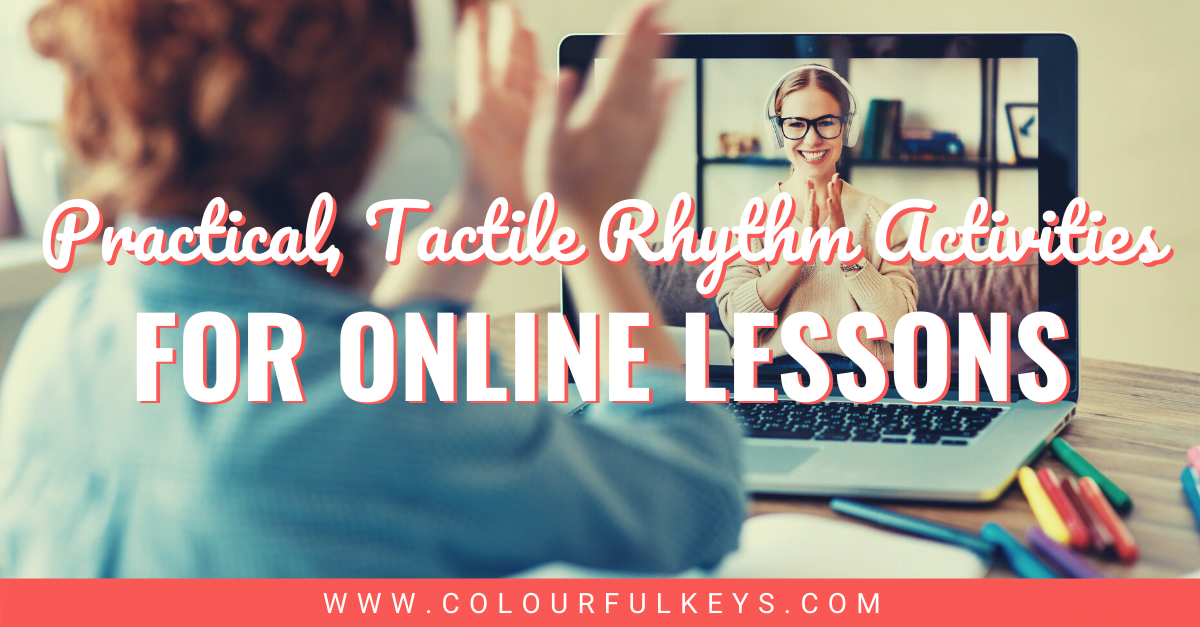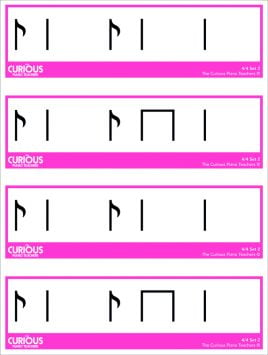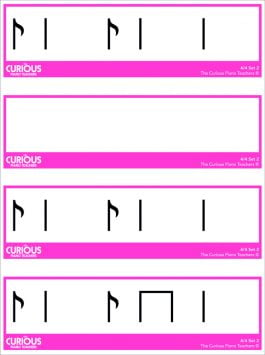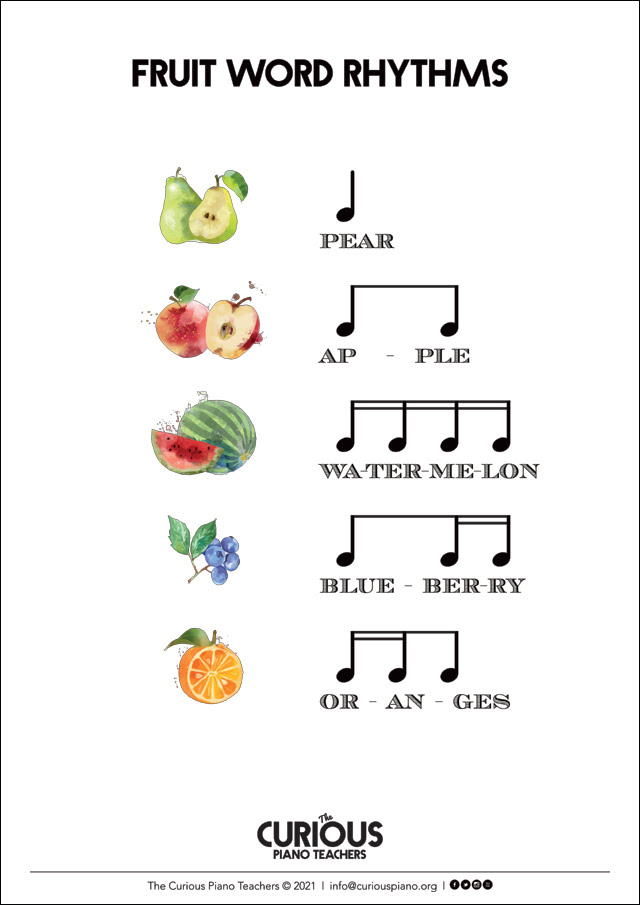This blog post about rhythm activities for online lessons was written by Sharon Mark-Teggart, MA. Sharon has 20 years of piano teaching experience and, since 2012, has delivered Associate and Licentiate teaching diploma courses to groups of piano teachers with well over 100 piano teachers successfully gaining accredited piano teaching diplomas. After founding evoco in 2012 (Northern Ireland’s Music Education Organisation,) Sharon founded The Curious Piano Teachers in 2015 with Dr. Sally Cathcart. She lives close to the beautiful Mourne Mountains in County Down, Northern Ireland with her husband Philip and 4 year-old son Reuel. You can read more about Sharon on her website.
To some degree or another, every piano teacher has struggled to maintain a good level of energy in online music lessons. Yet increased energy levels can be brought about by the smallest, the simplest things.

Maybe your toddler bursts in. Your student giggles at the intrusion! Maybe your cat jumps up on the piano keys – or worse still, knocks over your coffee. Maybe the doorbell rings and you have to take a few moments away from your screen to accept delivery of a parcel.
All of these very, very simple things will adjust the energy levels in the lesson, causing a smile or a giggle from both you and your student.
So, how can we leverage that bottled-up energy in a purposeful, musical way to bring a burst of engagement to our lessons?
Here are just a few of the fun rhythm activities for online lessons which I’ve used to engage my students during the past year. You’ll see that in most instances, I use tactile resources to help boost the energy in online lessons.
Online Rhythm Activity #1: TENNIS BALL
FEEL the beat and understand the rhythm.
One way I’ve been teaching rhythm in online lessons is with a tennis ball. (Sometimes a larger bouncy ball works well for younger students).
Ask your student to bounce and catch the ball repeatedly, then get them to actually say ‘bounce’ and ‘catch’ aloud in time with the ball.
Once the student has ‘verbalised’ the pulse beat, have them start counting the beat either metrically (1-2) or with rhythm syllables (ta ta.)
Finally, use digital rhythm flashcards to get your student to count a rhythm aloud, focusing on how it sounds within the regular beat set up by the ball.
In addition to using rhythm syllables (e.g. ta, ti-ti, ta-2) I also like to use ‘fruit’ word rhythms with my students to help them understand the subdivisions (e.g. pear, ap-ple, wa-ter-me-lon.)
Tips
Demonstrate to your students to keep the experience powerful and meaningful!
Ensure that there is nothing in the room which could easily get broken by the ball.
Further Ideas
Want to explore different metres?
Triple metre
- Beat 1 – bounce
- Beat 2 – catch (with one hand)
- Beat 3 – pass (to the other hand)
Quadruple metre
- Beat 1 – bounce
- Beat 2 – catch
- Beat 3 – throw
- Beat 4 – catch
Psst….Nicola has more awesome ideas for teaching metre and other rhythm concepts on her music theory page.
Online Rhythm Activity #2: PLATES & BLUEBERRIES
SEE the beat and understand the rhythm.
Ask your student to bring a set of plates to the lesson, along with a jar of blueberries/sweets/erasers.

Show them a rhythm flashcard either from the sets of digital rhythm flashcards above or another resource such as the Vibrant Music Teaching Rhythm Vocab Cards. Have your student recreate this rhythm using plates (showing the beat/pulse) and blueberries (showing the rhythm). They’ll then tap this rhythm and count aloud.
Tips
To show the metre, you might use a dinner plate for the 1st beat with side plates for the remaining beats.
Further Ideas
Ask your student to look at the piece they are learning and identify every bar with that rhythm pattern.
Ask your student to switch a plate around and tap the new rhythm pattern. Can they find this rhythm pattern in their piece?
Online Rhythm Activity #3: FOUR OBJECTS
Identify the Time Signature
Your student will need to come prepared to the lesson with four chosen objects small enough to be placed on a table. For young students this can be toys (be clear that a pet does not count as an ‘object’ – not even a goldfish!) For adult students this might be a bag of coffee, a packet of biscuits, a cafetière and a mug.
You will play a couple of pieces of music or share audio/video recordings. Your student will identify the metre of the music (duple/triple/quadruple) and respond by setting out the correct number of objects.
Tips
Find out a little more about the music they enjoy before doing this activity, so that you can use extracts from music they already know and love.
Further Ideas
Once the student has identified the correct metre, play the music again and ask them to show the beat with their tennis ball. Due to the time lag of online calls, it will not sound in time to you – so just let them get on with it!
You might even invite students to listen to their favourite song for homework and take a video of themselves showing the beat with a tennis ball.
Online Rhythm Activity #4: DIGITAL RHYTHM FLASHCARDS
Memorise a 4-bar Rhythm Pattern
When teaching rhythm in online lessons, it can be trickier to work on rhythm memorisation. In this next online rhythm activity, the aim is for the student to be able to tap 4 rhythm cards from memory.
I like start by showing my students a set of flashcards and get them talking about the patterns. For example, with the rhythm below they might say: “The first 2 beats are the same in every bar! There’s a syncopated rhythm pattern: quaver – crotchet – quaver.”
Ideally they might also spot that the last 2 beats are the same in bars 1 & 3 and bars 2 & 4.

Next, students will start by tapping and counting aloud the rhythm of all 4 cards. Tell your student which one card they need to memorise before moving to the next slide (where this rhythm card has been deleted).

When all rhythm cards have been removed and your student can tap all 4 bars fluently from memory, ask your student to notate the rhythm they’ve just memorised.

Click the links below to access special sets of digital rhythm memory flashcards featuring a variety of rhythm concepts:
- Set 1 – minims, crotchets/crotchet rests and quaver pairs (half notes, quarter notes/rests and eighth note pairs)
- Set 2 – syncopated patterns (quaver-crotchet-quaver or eighth note-quarter note-eighth note) and dotted crotchet + quaver/quaver rest (dotted quarter note + eighth note/eighth rest)
- Set 3 – semiquavers (sixteenth notes)
- Set 4 – dotted crotchet + quaver (dotted quarter note + eighth note) and quaver triplets (eighth note triplets)
Tips
It doesn’t matter how the student counts aloud – using either rhythm syllables or metrical counting. However, it’s really important that they do count out loud as this makes the learning more conscious.
If your student hasn’t yet grasped a particular rhythmic concept, then stick with the rhythms they can fluently count and tap.
Further Ideas
Invite your student to use their memorised rhythm to improvise at the piano with a limited set of notes. Or might they play a scale using that rhythm? Or find some of those rhythm patterns in a piece they’re currently learning?
GIVE THESE PRACTICAL IDEAS A WHIRL AT YOUR NEXT ONLINE LESSON
You don’t need to spend more than 5 minutes of lesson time on any of these ideas, provided you’ve asked your student to come equipped to their lesson with the objects required. (Otherwise, they will end up spending 5 minutes looking around the house for a tennis ball!)
I’d love you to give these practical, tactile online lesson ideas a whirl the next time you teach an online lesson. Let me know in the comments below how you and your students get on! 😊




Thank you for these wonderful ideas!!!